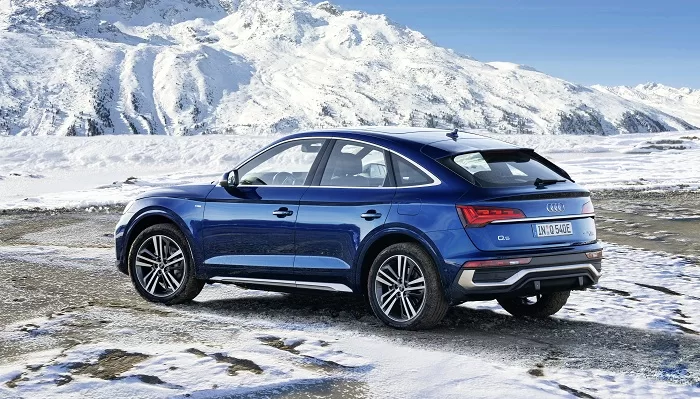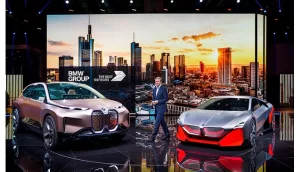The Q5 TFSI e quattro3 and Q5 Sportback TFSI e quattro4 each use a drivetrain with the same design – in both performance levels. It consists of a 2.0 TFSI gasoline engine with 195 kW (265 PS) of power and 370 Nm (272.9 lb-ft) of torque coupled with an electric motor. The permanently excited synchronous motor (PSM) reaches a peak output of 105 kW and a peak torque of 350 Nm (258.1 lb-ft). Together with the separating clutch, it is integrated into the seven-speed S tronic transmission, which transfers the drive torque to a quattro drivetrain with ultra technology. In normal driving operation, the drive is provided only via the front wheels for efficiency-related reasons. The rear axle is connected instantly as required. The quattro all-wheel drive system is thus ready immediately when needed.
The lithium-ion battery is located below the luggage compartment floor. It is made up of 104 prismatic cells and can store 14.4 kWh (net; 17.9 kWh gross) of energy with a voltage of 381 volts. For optimal temperature control, its cooling circuit is connected to both the coolant circuit for the air conditioning system and the low-temperature circuit that supplies the electric motor and power electronics. The air conditioning system comes as standard with an integrated highly efficient heat pump that bundles the waste heat from the high-voltage components.
It can generate a heat output of up to 3 kW with 1 kW of electric energy, which increases the car’s energy efficiency and provides a more comfortable climate for the occupants.
220 kW (299 PS) or 270 kW (367 PS): the two output levels
Since the two engine line-ups differ in terms of their boost strategy, they have a different system output and system torque. The Q5 Sportback 50 TFSI e quattro2 accelerates with 220 kW (299 PS) and 450 Nm (331.9 lb-ft) from 0 to 100 km/h (62.1 mph) in 6.1 seconds. The Q5 Sportback 55 TFSI e quattro1 accelerates with 270 kW (367 PS) and 500 Nm (368.8 lb-ft), enough for a standard sprint in 5.3 seconds.
In both engine line-ups, the maximum torque is already available just slightly above idle speed. That also contributes to the superior overall impression emanating from the plug-in hybrid drive. The electronically governed top speed of 239 km/h (148.5 mph) and the electric power and fuel consumption are identical in both output levels. When running purely on battery power, the plug-in hybrids can run up to 61 kilometers (37.9 mi) (WLTP) at a speed of up to 135 km/h (83.9 mph).
Drive modes and the predictive efficiency assist
Quiet and with zero local emissions in the city, with long ranges on long-distance trips, or sporty and dynamic with the combined power of the TFSI and the electric motor: The driving modes for the plug-in hybrids in the Q5 product line are versatile and intelligent. The concept is designed so that the driver can cover the majority of their daily routes on electric power. They can decide freely whether and how they wish to intervene in the interaction between the two motors; to do so, they can choose between four operating modes.
The hybrid mode is activated automatically with the route guidance in the navigation system but can also be selected manually via the operating mode button. In this mode, the battery charge is distributed optimally across the route in order to keep power consumption to a minimum. Downtown and in stop-and-go traffic, the Q5 and Q5 Sportback TFSI e quattro run mainly on battery power. The control function for the drive of the two plug-in hybrids is based on a large amount of data. This incorporates online traffic information, distance to the destination, the route profile of the chosen route, precise information about immediate surroundings from the navigation data, such as speed limits, types of roads, uphill and downhill slopes and the latest data from the on-board sensors. If route guidance is active in the MMI navigation system, the predictive operating strategy attempts to drive the last urban segment of the route all-electrically and arrive at the destination or charging station with the drive battery nearly empty.
With an eye toward efficiency: recharge or coast
When drivers takes their foot off the gas pedal of an Audi Q5 or Q5 Sportback TFSI e quattro, the drive management system decides, depending on the situation, between coasting with the engine shut off and power recuperation, that is the recovery of kinetic energy and its conversion into electrical energy. The electric motor performs all light decelerations up to 0.1 g and can generate an output of up to 25 kW. Brake recuperation extends up to 0.2 g and can recover up to 80 kW of electric power. The hydraulic disk brakes are activated only during heavier decelerations.
The predictive efficiency assist (PEA) adjusts the behavior of the coasting recuperation to the situation at hand. It uses the predictive route data from the navigation database and monitors the distance to the vehicle ahead using signals from the camera and radar. When the adaptive cruise control (ACC) is active, the PEA supports the driver by braking and accelerating automatically in order to further enhance efficiency and comfort.
When the driver is not using ACC, they receive hints indicating the right time to take their foot off the right-hand pedal. These hints take the form of a haptic impulse from the active accelerator pedal as well as visual displays in the cockpit and the optional head-up display. At the same time, symbols indicate the reason for the reduction in speed. Speed limits, town signs, curves and downhill slopes, roundabouts, intersections, highway exits, and traffic ahead are displayed.
Aside from the hybrid operating mode, the driver can choose between three further modes. In EV mode – the basic setting every time the vehicle is started – the car is driven exclusively electrically as long as the driver does not depress the accelerator past a variably perceptible pressure point. In Hold mode, battery capacity is held at the current level. In Charge mode, the drive management system increases the amount of energy in the battery with the aid of the internal combustion engine. As it does during recuperation, the electric engine then works as a generator, charging the drive battery.
Convenient: fast charging in just a few hours
All plug-in-hybrids in the Q5 family come as standard with the charging system compact for the garage. At an industrial electrical connection with 400 volts and 16 amperes, a full charge takes roughly 2.5 hours at 7.4 kWh of power. At a 230-volt household power socket, charging takes roughly 8 hours and 15 minutes. While on the road, the driver can also charge at public charging terminals with the standard mode 3 cable with a type 2 plug.
Audi’s proprietary Audi e-tron Charging Service makes charging on the road convenient by providing access to some 200,000 charging points in 26 European countries. One card is sufficient to start the procedure, regardless of the provider.
Charge management from the couch: the myAudi app
The myAudi app allows customers to use the services from the Audi connect portfolio on their smartphones, which is particularly attractive with the plug-in hybrid models. They can use the app to check the battery and range status, start the charging process, program the charge timer, and view the charge and consumption statistics. In addition, the route planners in both the app and the MMI navigation in the car show charging stations.
Another function of the myAudi app is pre-entry climate control before setting off. The customer can determine exactly how the interior should be heated or cooled while the battery is being charged. Pre-entry climate control even works when the car is not connected to the power grid – provided it has a sufficient state of charge. Audi offers comfort auxiliary air conditioning as an option. It allows the customer to specify a desired temperature and to also have the seats and windshield heated, depending on the equipment.
Lavish and sporty: features and design details
The plug-in hybrids in the Q5 product line are lavishly equipped The models include sport seats, three-zone automatic air conditioning, the convenience key, and hybrid-specific displays plus a powermeter as standard. The rear seats can be shifted longitudinally and their seat back angle can be adjusted.
Prices: starting at EUR 56,500
Presales of the Audi Q5 Sportback TFSI e quattro recently started in Europe. The 50 TFSI e2 – available in the “advanced” and “S line” trim – is priced starting at EUR 60,000 in Germany. The 55 TFSI e1 – available exclusively in the “S line” trim – starts at EUR 65,050.
The prices for the Q5 TFSI e quattro are EUR 56,500 for the less expensive variant in the basic version – “advanced” and “S line” are available as an option – or EUR 62,900 for the top-of-the-range engine line-up with S line equipment. When purchasing a new car, customers in Germany can claim a net subsidy of EUR 5,625 for all Q5 plug-in hybrids. As company cars, they are taxed at a flat rate of 0.5% of the gross list price.
Source: Audi














